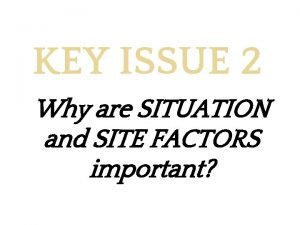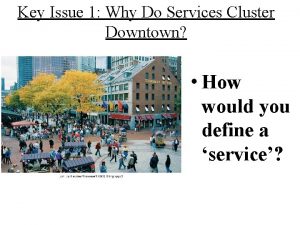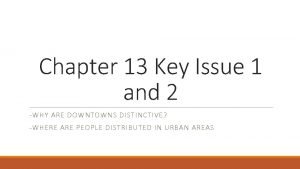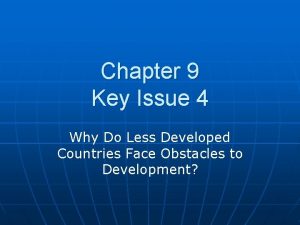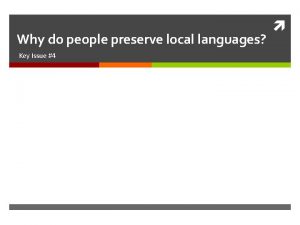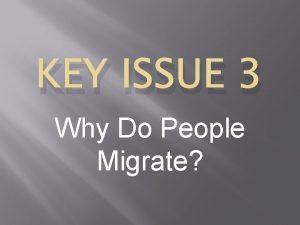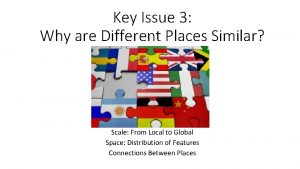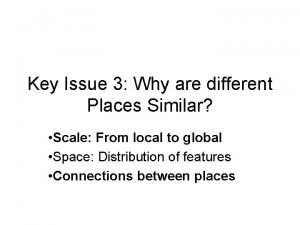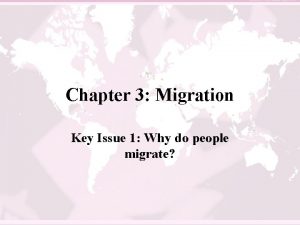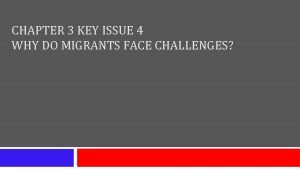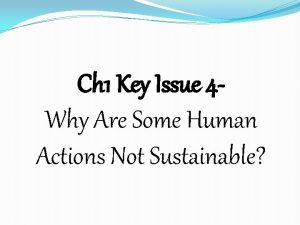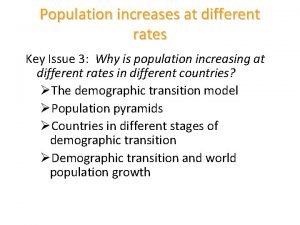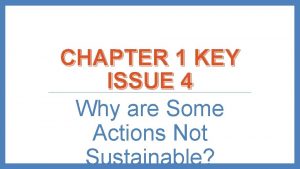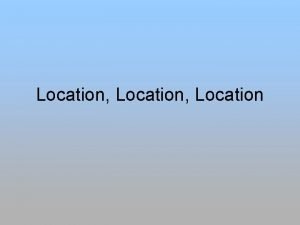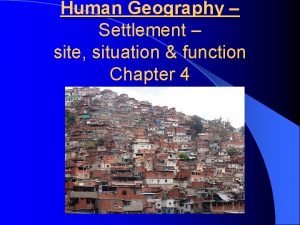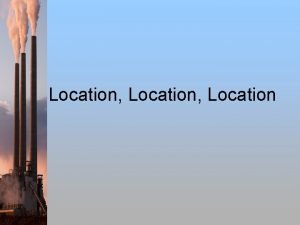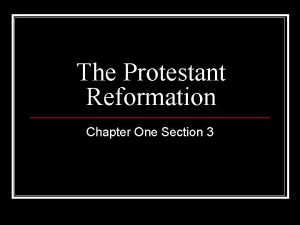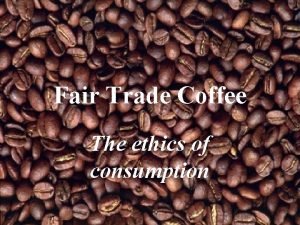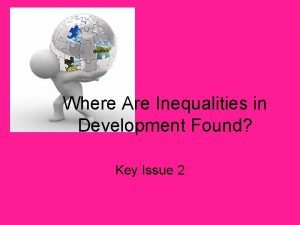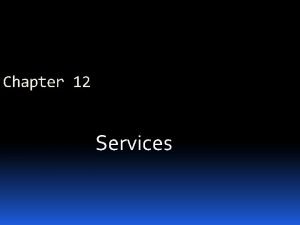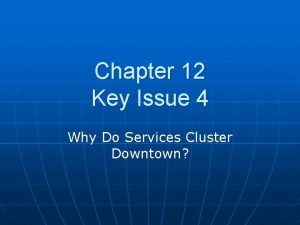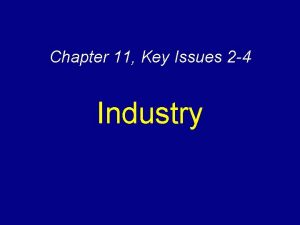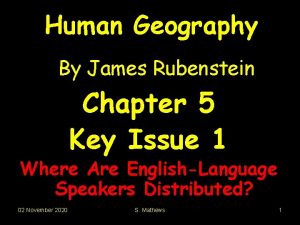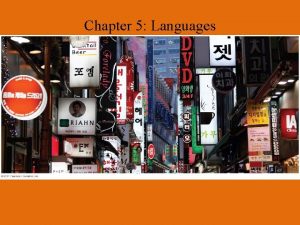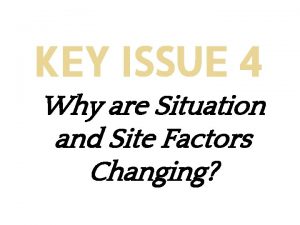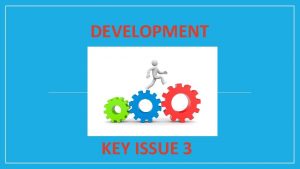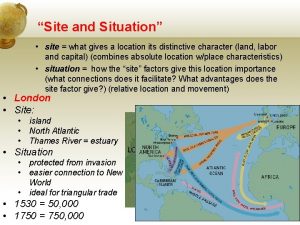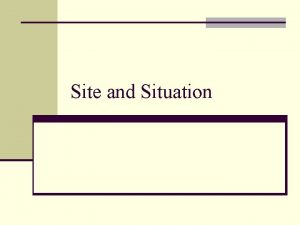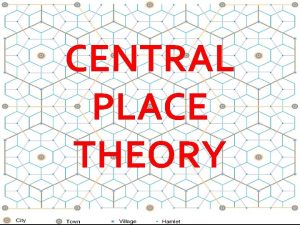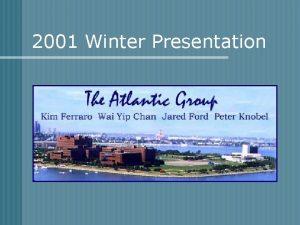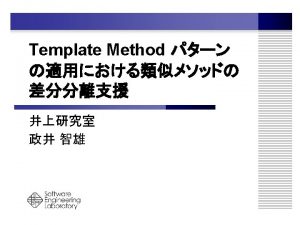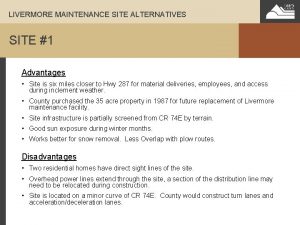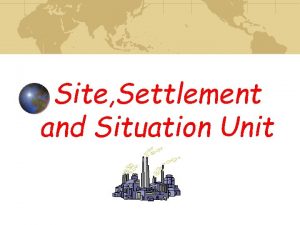KEY ISSUE 2 Why are SITUATION and SITE











































- Slides: 43

KEY ISSUE 2 Why are SITUATION and SITE FACTORS important?

#___: Site & Situation Factors 1. In what region is most corn grown in the US? 2. Ethanol, a type of alcohol, can be manufactured from corn. What relationship do you see between where corn is grown and where ethanol plants are located?

sample FRQ

Companies use two geographic factors to choose locations for factories: • SITUATION Factors involve the costs of transporting raw materials and finished goods. • SITE Factors involve the unique characteristics of particular location.

Weber’s Least Cost Theory • Alfred Weber (18681958) • German economic geographer • Published Theory of Location of Industries in 1909. • “What is the best (most profitable) location for manufacturing plants? ” “Just because I’m old doesn’t mean I don’t know what I’m talking about!”

3 major factors that determine location of manufacturing • 1. transportation--most important to Weber – Raw materials (inputs) to factory – Finished goods (outputs) to market – Distance and weight most important factors. • 2. labor – High labor costs reduce profit – May locate farther from inputs/ market if cheap labor can make up for added transport costs. • 3. agglomeration – Similar businesses cluster in the same area. – Businesses support each other, reduce costs

INPUTS are the materials needed for production, like ores or components parts. IRON ORE CAR COMPONENTS

The farther something is transported, the higher the cost. Thus, factories are located as close as possible to either inputs or markets.

If the cost of bringing raw materials to the factory is HIGHER than that of transporting finished goods, the factory is optimally located close to INPUTS.

If the cost of transporting finished goods is HIGHER than inputs, the factory is optimally located as close to the customer (market) as possible.

CERTAIN INDUSTRIES TRY TO LOCATE CLOSE TO MARKETS: • BULK-GAINING Industries • SINGLE-MARKET Industries • PERISHABLE Industries

BULK-GAINING industries are those whose finished products are heavier than inputs because weight is added during production. Ex. Soft drinks, beer, auto manufacturing

The heaviest part of any drink is water. Because water is available everywhere, beverage producers can ship lighter raw ingredients (bottles, syrups) to factories close to population centers (markets).

BULK GAINING can also refer to an industry whose final products are HARDER TO SHIP than inputs. STABLE INPUTS Fragile & Bulky Product Potato chips are a good example of this.

SINGLE-MARKET Industries are those that cater to a very limited number of purchasers, like a single industry or company. These industries locate close to customers to reduce shipping costs.

Car components are often built on contract by small manufacturers for large auto companies. Workers making seats for Fiat 500 Ls Component factories are located as close as possible to CAR ASSEMBLY PLANTS.

The world’s largest zipper manufacturer, YKK, has one customer – the garment industry. YKK produces zippers in factories all over the world, wherever major apparel industries can be found.

Producers of PERISHABLE products need to locate near consumers/markets to maintain the freshness of their products. Remember VON THUNEN’S MODEL?

Newspapers are PERISHABLE. Their content is time-sensitive and can be outdated after only one day. National newspapers, like the New York Times, are produced in locations around the country to reduce shipping lag.

BULK REDUCING industries are those whose finished products are lighter/have less volume than inputs. Ethanol is extracted from the corn plant. Much of the plant is discarded in the process.

Metals are very useful for manufacturing because they are (mostly) malleable, durable, and can conduct electricity. Copper is an example of a bulk-reducing mineral.

Manufacturers choose a their MODE OF TRANSPORT to match their situation and needs. The main four modes are TRUCK, TRAIN, BOAT, & PLANE. Over longdistances, ships tend to be most cost -effective.

Companies that use multiple transport modes utilize break-of-bulk points, which are locations where rapid transfer among different modes is possible.

As technologies and industries change, so do situation factors. An example is the evolution of the STEEL INDUSTRY from 1850 to today.

From the mid-19 th through the early 20 th century, American steel mills were located near inputs. As different inputs became more or less important, centers of production shifted.

Since the mid-20 th century, proximity to MARKETS has become more important than proximity to inputs. Finished steel is increasingly likely to be imported, and US production is increasingly focused on RECYCLING SCRAPS.


While the US was the world’s top steel producer in 1980, China holds that distinction today.

Car manufacturers attempt to locate their factories close to profitable markets. While cars were historically assembled in corporatebase countries ( Germany, Japan) and shipped abroad by boat, today they are assembled in factories across the world close to markets.


Most cars driven in any of the three major industrial regions were built/assembled in that region. MASSIVE TOYOTA PLANT IN BURNASTON, UK

Most US auto production occurs in an area known as AUTO ALLEY, from Michigan to the US South. Foreign carmakers take advantage of CHEAP LABOR in the South and Mexico; American carmakers focus production near their bases in Michigan and surrounding states.

Like in America’s AUTO ALLEY, auto manufacturers choose different sites for different reasons in EUROPE. Some utilize skilled labor & high industry in Northern Europe; others choose to utilize much cheaper labor in Southern/Eastern Europe.

SITE FACTORS Other than transportation costs (situation factors), THREE SITE FACTORS also largely determine where an industry will be located. These include: • LABOR • CAPITAL • LAND

LABOR For some industries, reducing labor costs is key to profitability. They will locate wherever labor costs ( wages, other compensation) are lowest.

LABOR-INTENSIVE industries are those where labor costs represent a very high percentage of their expenses. Textile manufacturing is one of the most labor-intensive industries. The opposite- where labor costs are a relatively low percentage- are CAPITALINTENSIVE industries.

CAPITAL Huge amounts of money are needed to construct and expand factories; industries locate wherever access to funds is most ready.

Some famous industrial regions developed because of the willingness of local lenders to invest. Two examples include: • DETROIT AUTO INDUSTRY • SILICON VALLEY

DETROIT’S AUTO INDUSTRY Lenders in Michigan were willing to invest heavily in the startup auto industry, while those on the East Coast closed their wallets to early auto investment. You could get a Ford Model T in any color you wanted – as long as it was black!

SILICON VALLEY, the center of US technological innovation, takes advantage of the highly-skilled workforce in California’s Bay Area. Silicon Valley is a technopole, a center of high-tech manufacturing and information-based quaternary industry. INVESTORS REWARD COMPANIES LOCATING HERE WITH CAPITAL FOR OPERATIONS AND EXPANSION

LAND Most early industries located in cities, where there was access to markets, labor, and to important nodes of early transportation – rail and ship. Many early factories were multi-story buildings IN the city.

Today, factories are designed on a single level , with an efficient stream of operations; materials enter one end, finished products exit the other.

Sprawling single-level factories require much more land than multi-level urban factories, so the land must be cheaper to buy. This factor- along with increasing reliance on TRUCK transportation- has moved most newer factories into the SUBURBS.
 Key issue 2: why are situation and site factors important?
Key issue 2: why are situation and site factors important? Antigentest åre
Antigentest åre Andreas carlsson bye bye bye
Andreas carlsson bye bye bye Why do services cluster downtown
Why do services cluster downtown Chapter 13 key issue 2
Chapter 13 key issue 2 Chapter 9 key issue 4
Chapter 9 key issue 4 Key issue 3 why do individual languages vary among places
Key issue 3 why do individual languages vary among places Languages
Languages Key issue 3 why do people migrate
Key issue 3 why do people migrate Why are different places similar?
Why are different places similar? Key issue 3 why are different places similar
Key issue 3 why are different places similar Chapter 3 key issue 1
Chapter 3 key issue 1 Chapter 3 key issue 4
Chapter 3 key issue 4 Key issue 4: why do migrants face obstacles?
Key issue 4: why do migrants face obstacles? Chapter 2 population and health key issue 3
Chapter 2 population and health key issue 3 Key issue 4 why are some actions not sustainable
Key issue 4 why are some actions not sustainable Key issue 3 why does population growth vary among regions
Key issue 3 why does population growth vary among regions Key issue 4 why are some actions not sustainable
Key issue 4 why are some actions not sustainable Hot site cold site warm site disaster recovery
Hot site cold site warm site disaster recovery Site vs location
Site vs location Difference between site and situation
Difference between site and situation Site vs situation factors
Site vs situation factors Dont ask
Dont ask Site vs situation
Site vs situation Key partners canvas
Key partners canvas Contoh bisnis model canvas makanan pdf
Contoh bisnis model canvas makanan pdf Protestant reformation worksheet answer key
Protestant reformation worksheet answer key What is fair trade coffee why is it an ethical issue
What is fair trade coffee why is it an ethical issue Where are inequalities in development found
Where are inequalities in development found Chapter 13 key issue 3
Chapter 13 key issue 3 Chapter 12 key issue 1
Chapter 12 key issue 1 Chapter 12 key issue 1
Chapter 12 key issue 1 Chapter 11 key issue 4
Chapter 11 key issue 4 Where did agriculture originate
Where did agriculture originate Chapter 5 key issue 1
Chapter 5 key issue 1 Chapter 5 key issue 4
Chapter 5 key issue 4 Chapter 4 key issue 3
Chapter 4 key issue 3 Chapter 13 key issue 4
Chapter 13 key issue 4 Chapter 12 key issue 2
Chapter 12 key issue 2 Chapter 5 key issue 1 ap human geography
Chapter 5 key issue 1 ap human geography Chapter 6 key issue 4
Chapter 6 key issue 4 Key issue 1 where are languages distributed
Key issue 1 where are languages distributed Chapter 5 key issue 2
Chapter 5 key issue 2 Chapter 4 key issue 2
Chapter 4 key issue 2
